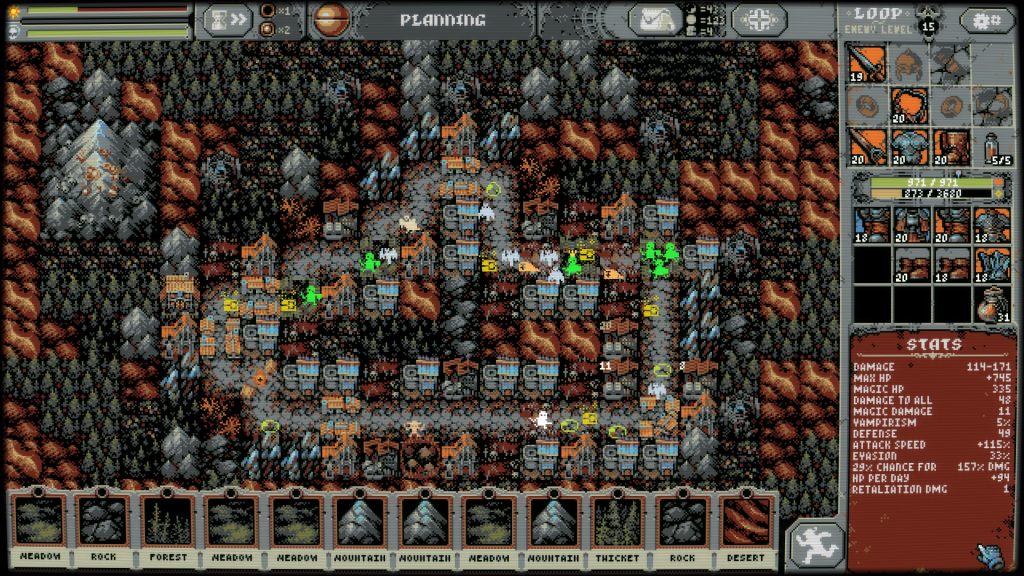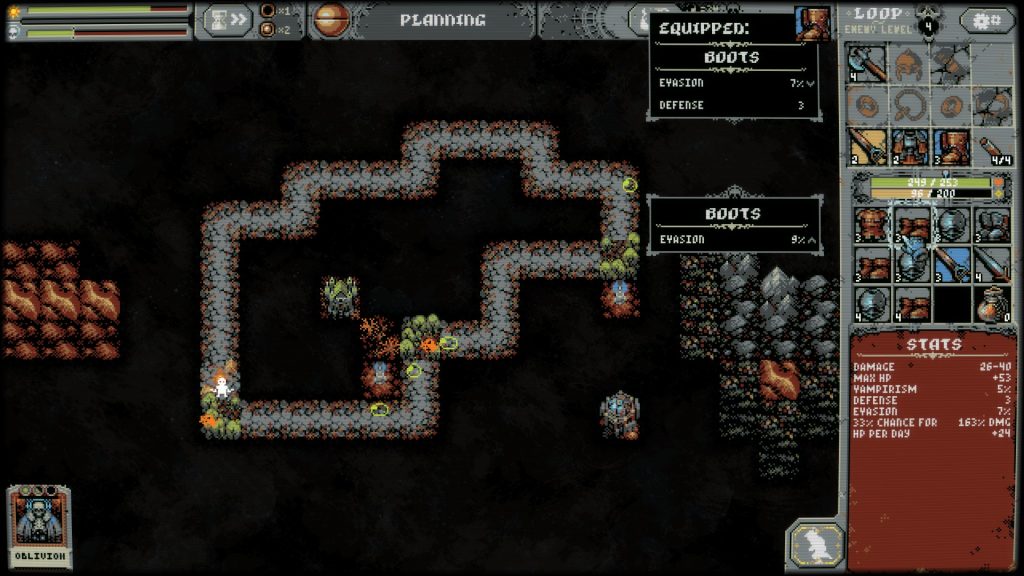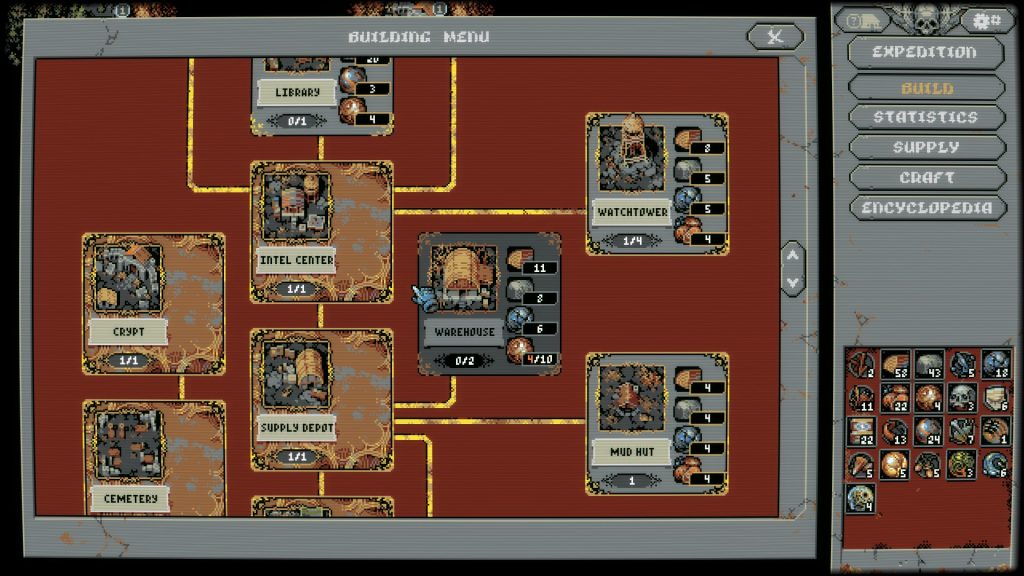Of the recent Steam festival offerings, Loop Hero was one that showed the most potential with an amazing concept and gothic pixel art style. With the game finally out, the design has some brilliant elements to it, but I feel it just misses being amazing.
Loop Hero was Played with a press key provided by the publisher.
Staring into the Abyss
Our story finds the entire universe has been destroyed, with only one figure left to try and put things together again. The gameplay straddles the line between a roguelike and an idle game. On each run, the path, or loop, is procedurally generated. The main character walks along the route fighting anything that gets in their way. Killing enemies will drop gear that can be equipped, materials for upgrading (more on that later), and cards. The cards, which are chosen from the player’s deck before they start, can be placed on the map to change the world.
Some cards will directly benefit the player the more that are placed. Others will generate new and harder enemies that can cause trouble. For every completed walk around on the loop, the enemy levels will grow progressively higher. Your mission is to put enough tiles on the map that you can survive the enemies and be able to summon and defeat the boss when enough of the world has been restored. To help your chances, you can equip procedurally generated gear that can provide added benefits and unlock new cards and features at your home base in-between runs.
The design is a brilliant combination of idle design, with the persistence and run focus of a roguelite. The dynamic between card placements and their impact on the run is the best part of Loop Hero but is also where I feel the problems begin.
All Risk, Little Reward
The genius of Loop Hero’s design is also where the first big problem with it occurs. The gameplay loop is all about essentially fashioning the rope to hang yourself with: how hard do you want to make each loop and hope that the rewards justify the risk? With rare exception, every tile placed is going to generate something that is going to get in your way. Advanced tiles can remove your ability to regenerate health, summon something very dangerous if you place too many, or work with other tiles to your benefit/misfortune.
When you start playing, you are required to take a certain number of cards total, and from each grouping. As you set them up throughout the map, the game is becoming harder under the assumption that you are earning more rewards for doing so. Except that is a complete lie, and the game misses some major potential because of it.
Everything in terms of rewards is calculated on an enemy-by-enemy basis. It doesn’t matter if a square contains 1 or 4 enemies in it, your rewards are tabulated one at a time with the exception to getting one specific resource. Question: When should you build the map to have a goblin, spider, vampire, and skeleton all on the same square? It’s a trick question, you never want that to happen. Unless you are trying to gather a specific resource, you never want to see enemies group up, they don’t give you bonus experience, or a greater drop chance. Harder enemies do have a greater chance of dropping better loot, but that is not as good as it sounds, and I’ll come back to that point in the next section. The game missed an opportunity to really reward the player for taking risks when it comes to card placement.
Because you have no direct control over your character, it means that you always want to play it safe when it comes to card placement. This reduces not only the number of viable ways to play Loop Hero, but also what cards to take. Some cards are so good or offer so much utility, there is never a reason not to include them (such as the meadow). Likewise, bringing the swamp that disables any regenerating health abilities is just asking for trouble. Certain combinations are very difficult to deal with, and there are often easier and safer ways to get the resources you need. The dynamics of card combos are very limited, and you will find out very early on what are the best to take. I do like how there are certain card synergies that change their properties on the field, but once again the number of possibilities is shorter than I would have preferred.
Unlucky Loot
As someone who has spent way too much time in ARPGs studying loot tables and loot design, to put it simply, the loot system in Loop Hero is flawed. To explain why I need to go on a quick loot lecture about how it works. Loot in Loop Hero is broken down by type, rarity, level, and then random modifiers are attached when generated. Each class gets its own set of equipment that can possibly drop, along with certain modifiers that are unique/specific to it. Higher rarity determines how many potential modifiers are attached, and the level itself is supposed to dictate the possible stat ranges of said modifiers.
In theory, getting higher-level loot is supposed to give you better stats, except that doesn’t happen as much as it should. The base stat of a piece of gear is often directly tied to level, but not the modifiers themselves. What ends up happening far more than it should is that I get a higher-level drop, sometimes even higher rarity, and its worse than something that is lower level that I’m using, even with the same modifiers.
Due to the hands-off nature of the design, modifiers become exceedingly more important when it comes to defining your build. For the rogue class, your main form of mitigating damage is evasion, and without getting drops that give you a high rate, you’re going to get in trouble. The issue is that your opportunities for acquiring new gear are limited, especially as the rogue class.
Case in point, let’s say you get lucky and get a high-level shield and armor with good modifiers, but without finding comparative weapons, you’re not going to be able to kill enemies fast enough before they chip you down. Getting good weapons means you can kill them fast, but without a defensive option, there’s no way you’ll survive to the boss.
Far too many times it felt like I lost because there was nothing, I could do to make the drops better. As you make each loop and the overall enemy level goes up, the quality of the loot in theory should be getting better. However, the itemization has the same exact problem that Diablo 3 had at 1.0 — the stat ranges are too wide. The general concept was by having wide variables for gear generation, it can lead to those “spiky” builds when you suddenly get a super high stat. The problem is that the low end is so low that it’s more than likely you’re going to get a lot of trash equipment, even when it’s a higher level. Compounding that, even as the enemies scale up, I was still getting loot drops 3 or more levels below their level; further increasing the chance I was going to get something I don’t need.
There are also too few useful modifiers for gear. While I do like how each class has modifiers that are exclusive to them, it would have been interesting, and make choices less cut and dry, if there were a greater pool of modifiers that could impact things.
I will bet that there are going to be readers here lining up to complain that I’m bad at the game, because “I never had a problem with the item drops, you must be bad at the game.” And that’s the nature of RNG, it’s the same thing that happened in Diablo 3, and it’s the same thing that happens in any procedural-based system for itemization. From talking with people, the game seems to prioritize gear level drops based on the gear you’re using — if I’m using all really good level 3 gear, most likely the game is going to drop more level 3 gear even if I’m fighting enemies several times higher. If this is how it works, this is a bad system because it reduces the choices when playing, muddies up the itemization, and contradicts what the game itself says about loot drops only being based on enemy level.
Grinding Up
Ultimately Loop Hero is on the hard side not only due to the RNG and idle combat but to the amount of grinding you’re going to need to do to stand a chance. Your settlement can be upgraded multiple times with new buildings and services by using the resources you earn. Different resource types are tied to different enemies, some come from plant-based enemies, some from the undead, and so on. The amount of grinding required to get some of the major buildings (or upgrade normal ones) is very high, and this is compounded by the design of the game.
Each harder chapter of Loop Hero increases the number of resources you can bring back when successfully surviving. If you die during a loop, you only retain 30% of the resources earned; early retreat nets you 60% and winning or retreating at the camp gets you 100%. The issue is that the game is clearly designed to take full advantage of you having the upgrades, as the difficulty spikes going from chapter 1 to chapter 2 (and with each new chapter). The main reason is that enemies gain additional perks with each new chapter; making them more dangerous and annoying to fight. The buildings you can construct can provide you with new cards, new game systems, and new classes.
The problem with this design is that it was handled more elegantly in Hades and how that game always felt like something new was unlocked win or lose. You’ll quickly exhaust all the story beats and scenes, and all you’re left with is the grinding, the resource hunt, and the void itself. Due to the hands-off design, Loop Hero is not really a game defined by the variance between runs but is more like a puzzle that you need to figure out the right combination of cards and gear, and get lucky, to succeed.
Because of that last point, it does rob the game of some of the joy of playing a roguelike or idle game. The high-end play of these designs is all about learning how to effectively break the design in your favor using the systems available. With Loop Hero, it feels like due to the limitations of play and the loot system, that there is one right way to play each class. Trying to do anything outside of that will be met with punishment when you’re not able to handle things due to the luck of the draw. From a UI standpoint and as a side note, the game needs a times three or times four speed for resource grinding runs.
Ouroboros-Like
The design of Loop Hero hits that sweet spot in terms of being just hands-off enough to make it approachable but still requires strategy and thinking to succeed. I really do love this concept, but this is also a game where if one element is out of alignment then the whole thing falls apart. What I wanted to see was more card combinations, more enemies, and more ways to manipulate the field, and that’s not what is happening here. Too often my successful runs boil down to me playing it the same way every time, and my failures are when I try to do something different or interesting. This is one of those times where I imagine a better game in my head, but Loop Hero is very close to that vision.
Please note that this was written and played with the retail 1.0 version of the game. There is always the chance that the game receives new content and balance patches to fix the issues mentioned and the possibilities and potential are here to make Loop Hero the next amazing take on roguelike design.
For more on my thoughts on roguelike design, be sure to check out my latest book “Game Design Deep Dive Roguelikes” coming in April with preorders open.
If you enjoyed my post, consider joining the Game-Wisdom discord channel open to everyone.




